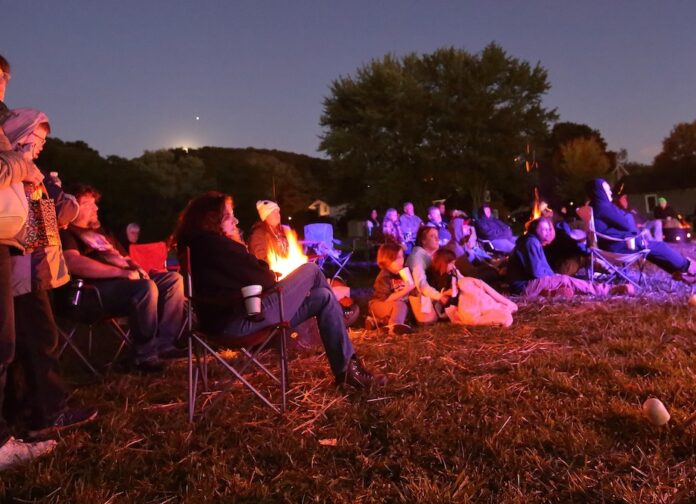
DARLINGTON, Pa. — More than 200 years after her life ended, Barbara Davidson is still captivating people. Back in her day, the 1790s, she was known as a beautiful and sociable young lady who attracted many suitors.
Today, more people probably know her for what happened after she died. She’s the Pig Lady, the ghost of a murdered woman who wears the head of a pig in place of her missing human head. Or sometimes she’s just a ghost without a head. Sometimes she’s just a floating head.
It depends on which version of the story you hear. The story of Barbara Davidson has grown and morphed, changing over time. It’s picked up details and lost others, taking on new meaning to fit the era and context in which it is being told.
“It’s a classic folk phenomenon where people start to run with the story and the story starts to evolve,” said Kevin Farkas, founder of The Social Voice Project, a public interest media production outlet based in Beaver County.
Celebrating folklore
In an effort to celebrate local folklore and encourage people to explore their own folkways, Farkas’s Social Voice Project is hosting an event, the Fall Folklore Celebration of Appalachian Beaver County, at 6:30 p.m. Oct. 14 at the New Galilee Community Center, 606 Centennial Ave., New Galilee, Pennsylvania.
This year the event will feature the annual retelling of the Barbara Davidson tale, as well as presentations on Appalachian storytelling through music, the folk tradition of tarot and a paranormal investigation at the Barbara Davidson homestead.
The event has seen several iterations over the years. The Pig Lady story was first capitalized on a decade ago through a haunted barn attraction, hosted as a fundraiser by the local Lions Club.
Farkas, who focuses his work on preserving and promoting local history and culture, came on board and shifted the event to be more of a celebration of the region’s Appalachian culture and history, with a spooky twist. The event is now held in conjunction with the Little Beaver Lions Club’s PumpkinPalooza, which includes a car cruise and children’s activities during the day.
Farkas brings in different guests to talk about different facets of Appalachian folklife each year. Last year, a speaker gave a presentation on Appalachian witchery and folk magic, like the use of dowsing rods, making herbal medicines or planting crops by the phases of the moon.
“We’re distinct up here from the Appalachian folkways you think of in the south, but in very many ways, we’re similar,” Farkas said.
The story lives on
The Pig Lady story is a great example of how folklore is made. It starts with a kernel of truth.
“There was a Barbara Davidson who was murdered,” Farkas said. “It’s unsolved.”
At its heart, it’s a true crime story. Farkas thinks that’s part of what draws people in.
The basic story is that 18-year-old Barbara lived with her family in a newly settled area in western Pennsylvania, what would later become the village of Cannelton, an unincorporated area within Darlington Township.
In the summer of 1795, Barbara stayed home to tend the farm while her parents went on a trip to Pittsburgh to buy supplies. When the family returned, Barbara was gone. They searched the area for days, but couldn’t find her. Eventually, a foul smell drew them to look in the crawl space under their home. There they found her decapitated corpse. Barbara’s head was never found, nor was her killer.
Over the many decades since her death, various accounts of Barbara’s ghost have been recorded and passed down orally. Her origin as the Pig Lady is believed to have come about rather recently, within the past 50 or so years, but it’s such a horrifying image that it’s now become the prominent storyline.
How to capture it
Every small town has a story like this. Heck, every family has a story like this. Storytelling and folklore are key parts of folkways, or the customs and conventions of daily life that are shared by a social group, Farkas said. But it’s more than just stories.
It’s the stuff done on back porches, in the kitchens or in farm fields in your community, he said. It’s language, music, dance, games, rituals, customs, handicrafts and art.
Folkways are not all sensational, supernatural or gruesome as the Pig Lady, but they’re all worth recording and remembering.
“We take this stuff for granted,” Farkas said. “Many of these cultural traditions are things that are passed down orally. They could be lost if one person dies … That’s the reason to find this stuff, document it, celebrate it and pass it on.”
For more information on the Fall Folklore Celebration, visit thesocialvoiceproject.org/the-pig-lady-folklore-celebration-2023/plffc-2023-activities/.
(Editor Rachel Wagoner can be reached at 724-201-1544 or rachel@farmanddairy.com. She grew up in Cannelton. Speaking of folkways, her husband’s family plans their sauerkraut-making in the fall by the phase of the moon. If you have an interesting story, tradition or folkway to share, feel free to reach out.)









